Input interpretation

1, 2-dibromo-1, 1, 2-trichloroethane
Basic properties
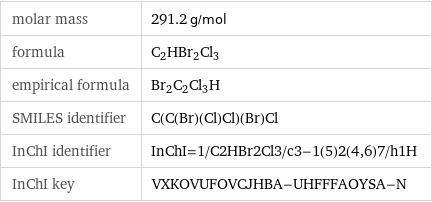
molar mass | 291.2 g/mol formula | C_2HBr_2Cl_3 empirical formula | Br_2C_2Cl_3H_ SMILES identifier | C(C(Br)(Cl)Cl)(Br)Cl InChI identifier | InChI=1/C2HBr2Cl3/c3-1(5)2(4, 6)7/h1H InChI key | VXKOVUFOVCJHBA-UHFFFAOYSA-N
Lewis structure
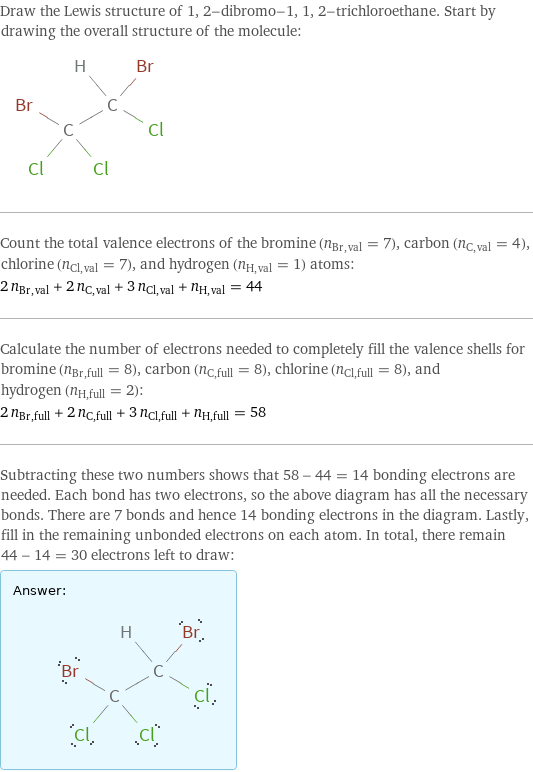
Draw the Lewis structure of 1, 2-dibromo-1, 1, 2-trichloroethane. Start by drawing the overall structure of the molecule: Count the total valence electrons of the bromine (n_Br, val = 7), carbon (n_C, val = 4), chlorine (n_Cl, val = 7), and hydrogen (n_H, val = 1) atoms: 2 n_Br, val + 2 n_C, val + 3 n_Cl, val + n_H, val = 44 Calculate the number of electrons needed to completely fill the valence shells for bromine (n_Br, full = 8), carbon (n_C, full = 8), chlorine (n_Cl, full = 8), and hydrogen (n_H, full = 2): 2 n_Br, full + 2 n_C, full + 3 n_Cl, full + n_H, full = 58 Subtracting these two numbers shows that 58 - 44 = 14 bonding electrons are needed. Each bond has two electrons, so the above diagram has all the necessary bonds. There are 7 bonds and hence 14 bonding electrons in the diagram. Lastly, fill in the remaining unbonded electrons on each atom. In total, there remain 44 - 14 = 30 electrons left to draw: Answer: | |
Estimated thermodynamic properties
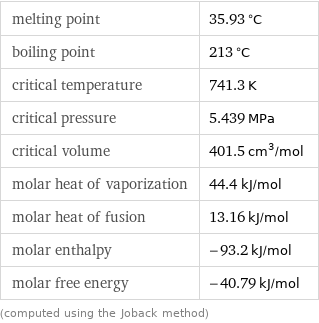
melting point | 35.93 °C boiling point | 213 °C critical temperature | 741.3 K critical pressure | 5.439 MPa critical volume | 401.5 cm^3/mol molar heat of vaporization | 44.4 kJ/mol molar heat of fusion | 13.16 kJ/mol molar enthalpy | -93.2 kJ/mol molar free energy | -40.79 kJ/mol (computed using the Joback method)
Units

Quantitative molecular descriptors

longest chain length | 4 atoms longest straight chain length | 4 atoms longest aliphatic chain length | 2 atoms aromatic atom count | 0 atoms H-bond acceptor count | 0 atoms H-bond donor count | 0 atoms
Elemental composition

Find the elemental composition for 1, 2-dibromo-1, 1, 2-trichloroethane in terms of the atom and mass percents: atom percent = N_i/N_atoms × 100% mass percent = (N_im_i)/m × 100% Plan: • Write the chemical formula and gather atomic masses from the periodic table. • Determine values for N_i, m_i, N_atoms and m using these items. • Finally, compute the percents and check the results. Write the chemical formula: C_2HBr_2Cl_3 Use the chemical formula to count the number of atoms, N_i, for each element and find the total number of atoms, N_atoms, per molecule: | number of atoms Br (bromine) | 2 C (carbon) | 2 Cl (chlorine) | 3 H (hydrogen) | 1 N_atoms = 2 + 2 + 3 + 1 = 8 Divide each N_i by N_atoms to calculate atom fractions. Then use the property that atom fractions must sum to one to check the work: | number of atoms | atom fraction Br (bromine) | 2 | 2/8 C (carbon) | 2 | 2/8 Cl (chlorine) | 3 | 3/8 H (hydrogen) | 1 | 1/8 Check: 2/8 + 2/8 + 3/8 + 1/8 = 1 Compute atom percents using the atom fractions: | number of atoms | atom percent Br (bromine) | 2 | 2/8 × 100% = 25.0% C (carbon) | 2 | 2/8 × 100% = 25.0% Cl (chlorine) | 3 | 3/8 × 100% = 37.5% H (hydrogen) | 1 | 1/8 × 100% = 12.5% Look up the atomic mass, m_i, in unified atomic mass units, u, for each element in the periodic table: | number of atoms | atom percent | atomic mass/u Br (bromine) | 2 | 25.0% | 79.904 C (carbon) | 2 | 25.0% | 12.011 Cl (chlorine) | 3 | 37.5% | 35.45 H (hydrogen) | 1 | 12.5% | 1.008 Multiply N_i by m_i to compute the mass for each element. Then sum those values to compute the molecular mass, m: | number of atoms | atom percent | atomic mass/u | mass/u Br (bromine) | 2 | 25.0% | 79.904 | 2 × 79.904 = 159.808 C (carbon) | 2 | 25.0% | 12.011 | 2 × 12.011 = 24.022 Cl (chlorine) | 3 | 37.5% | 35.45 | 3 × 35.45 = 106.35 H (hydrogen) | 1 | 12.5% | 1.008 | 1 × 1.008 = 1.008 m = 159.808 u + 24.022 u + 106.35 u + 1.008 u = 291.188 u Divide the mass for each element by m to calculate mass fractions. Then use the property that mass fractions must sum to one to check the work: | number of atoms | atom percent | mass fraction Br (bromine) | 2 | 25.0% | 159.808/291.188 C (carbon) | 2 | 25.0% | 24.022/291.188 Cl (chlorine) | 3 | 37.5% | 106.35/291.188 H (hydrogen) | 1 | 12.5% | 1.008/291.188 Check: 159.808/291.188 + 24.022/291.188 + 106.35/291.188 + 1.008/291.188 = 1 Compute mass percents using the mass fractions: Answer: | | | number of atoms | atom percent | mass percent Br (bromine) | 2 | 25.0% | 159.808/291.188 × 100% = 54.88% C (carbon) | 2 | 25.0% | 24.022/291.188 × 100% = 8.250% Cl (chlorine) | 3 | 37.5% | 106.35/291.188 × 100% = 36.52% H (hydrogen) | 1 | 12.5% | 1.008/291.188 × 100% = 0.3462%
Elemental oxidation states

The first step in finding the oxidation states (or oxidation numbers) in 1, 2-dibromo-1, 1, 2-trichloroethane is to draw the structure diagram. Next set every oxidation number equal to the atom's formal charge: In 1, 2-dibromo-1, 1, 2-trichloroethane hydrogen is not bonded to a metal with lower electronegativity, so it will have an oxidation state of +1. Any element bonded to hydrogen gains the bonding electrons, decreasing their oxidation state by 1 for every bond: With hydrogen out of the way, look at the remaining bonds. There are 2 bromine-carbon bonds, 3 carbon-carbonl bonds, and 1 carbon-carbon bond. For each of these bonds, assign the bonding electrons to the most electronegative element. First examine the bromine-carbon bonds: element | electronegativity (Pauling scale) | Br | 2.96 | C | 2.55 | | | Since bromine is more electronegative than carbon, the electrons in these bonds will go to bromine. Decrease the oxidation number for bromine in every highlighted bond (by 1 for single bonds, 2 for double bonds, and 3 for triple bonds), and increase the oxidation number for carbon accordingly: Next look at the carbon-carbonl bonds: element | electronegativity (Pauling scale) | C | 2.55 | Cl | 3.16 | | | Since chlorine is more electronegative than carbon, the electrons in these bonds will go to chlorine: Next look at the carbon-carbon bond: element | electronegativity (Pauling scale) | C | 2.55 | C | 2.55 | | | Since these elements are the same the bonding electrons are shared equally, and there is no change to the oxidation states: Now summarize the results: Answer: | | oxidation state | element | count -1 | Br (bromine) | 2 | Cl (chlorine) | 3 +1 | C (carbon) | 1 | H (hydrogen) | 1 +3 | C (carbon) | 1
Orbital hybridization
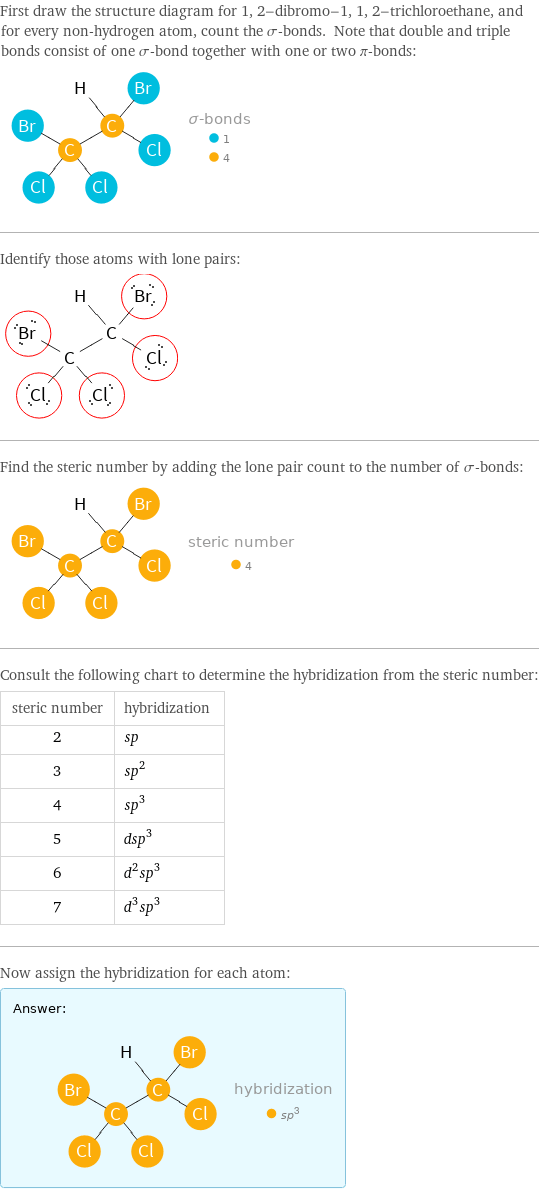
First draw the structure diagram for 1, 2-dibromo-1, 1, 2-trichloroethane, and for every non-hydrogen atom, count the σ-bonds. Note that double and triple bonds consist of one σ-bond together with one or two π-bonds: Identify those atoms with lone pairs: Find the steric number by adding the lone pair count to the number of σ-bonds: Consult the following chart to determine the hybridization from the steric number: steric number | hybridization 2 | sp 3 | sp^2 4 | sp^3 5 | dsp^3 6 | d^2sp^3 7 | d^3sp^3 Now assign the hybridization for each atom: Answer: | |
Topological indices
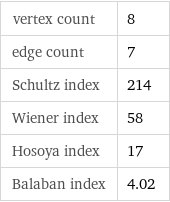
vertex count | 8 edge count | 7 Schultz index | 214 Wiener index | 58 Hosoya index | 17 Balaban index | 4.02